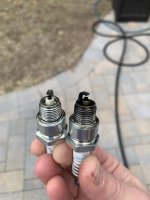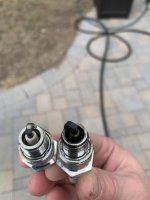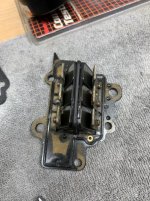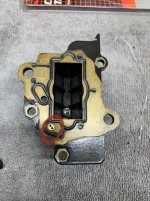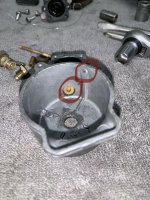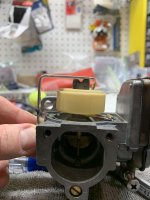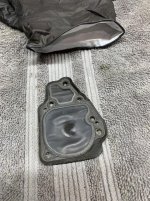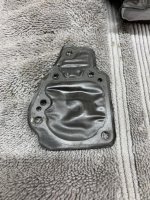First, thanks to everyone that has helped me so far, as I've posted a couple of times as I worked my way through trying to get a 2002 Mercury 15hp short shaft 2 stoke outboard to run right. It still won't though. It seems to load up (rich) and then cough a big puff out of the exhaust, then drop off. Let it run long enough, and the idle will slow down and it will stall. Give it gas, and it will bog, or pop/cough like in this video.
https://www.dropbox.com/s/ebr8hexck07q36s/IMG_0875.MOV?dl=0
Here's some info on it...it will start pretty easily. When it dies, it can be really hard to restart. Usually you need to turn the primer knob to FAST and it will catch. It's was like this last season too. Once running, it will run for a while, and then slow down or if you get into the gas, it pops like I mentioned. Last season, we did use it and it was ok for the most part, but always fussy with hard starts and restarts and stalls sometimes.
I'm pretty handy and have checked quite a bit. Here's the list of what I've looked at and done...
1. Carb cleaned (no improvement), but I'm even doing it again in the ultrasonic cleaner (as I write this).
2. Confirmed plug wires were bad. Intermittent connections. New wires installed.
3. New thermostat (although that had nothing to do with any of this, it just needed it).
4. New fuel filter and O ring.
5. Checked reed block, reeds all look great.
6. New plugs, and confirmed good spark using an adjustable gap tester. Spark jumped a 1/2" gap with a nice blue spark. Same for both cylinders. Also confirmed proper gap of 0.060"
7. Confirmed the ignition coils ohmed out correctly.
8. Found the kill switch in the tiller handle was bad (removed that). New one arriving tomorrow.
9. Verified the safety lanyward kill switch ohms out correctly (open, or .5 ohm when activated).
10. New fuel and the proper mix, 50:1.
11. Adjusted carb float, as it was way out of spec. It was only at about 1/4" from bottom of bowl, vs the 1" the service manual stated. I adjusted the lever in the bowl to allow it to rise to the proper level.
12. Checked compression and while low, both cans were 105psi dead on.
And the darn thing still won't run right! A few things I've noticed...so here's the questions, in addition to any other advice anyone might have.
1. Look at the plugs in the pics below. One was fouled, the other looked like it was very lean. Why such a difference?
2. And then on the reed block, at the bottom left there's two small holes that look like they allow the crankcase to bleed through the reed block, back into the carb into the overflow hose under the carb. It's circled in the pic. I noticed there's like a small piece of plastic in there that blocks the passage a bit. Seems like it moves around. Is it some type of check valve? Or should those holes both be clear and I should try to get it out. Seems like in most cases, only one holes is blocked at a time, but I could be wrong.
3. On the carb bowl, I'm curious about the bowl and two things related the primer circuits. Both areas are circled in the pic. First, the brass insert at the bottom of the bowl. It seems like there's a small brass flapper valve or something. Could that be damaged and somehow causing a problem? And the hole at the top of the bowl that is circled. Is that a tube going somewhere? It's seems blocked so it's either clogged or not a circuit. Why the hole then? Hoping the ultrasonic cleaner opens it up if it is supposed to pass fuel.
I'm handy with tools, and like to learn. Not afraid to do too much, but I'm thinking it's something stupid. The three things to have an engine run, spark, fuel and air. I think I have them all.
https://www.dropbox.com/s/ebr8hexck07q36s/IMG_0875.MOV?dl=0
Here's some info on it...it will start pretty easily. When it dies, it can be really hard to restart. Usually you need to turn the primer knob to FAST and it will catch. It's was like this last season too. Once running, it will run for a while, and then slow down or if you get into the gas, it pops like I mentioned. Last season, we did use it and it was ok for the most part, but always fussy with hard starts and restarts and stalls sometimes.
I'm pretty handy and have checked quite a bit. Here's the list of what I've looked at and done...
1. Carb cleaned (no improvement), but I'm even doing it again in the ultrasonic cleaner (as I write this).
2. Confirmed plug wires were bad. Intermittent connections. New wires installed.
3. New thermostat (although that had nothing to do with any of this, it just needed it).
4. New fuel filter and O ring.
5. Checked reed block, reeds all look great.
6. New plugs, and confirmed good spark using an adjustable gap tester. Spark jumped a 1/2" gap with a nice blue spark. Same for both cylinders. Also confirmed proper gap of 0.060"
7. Confirmed the ignition coils ohmed out correctly.
8. Found the kill switch in the tiller handle was bad (removed that). New one arriving tomorrow.
9. Verified the safety lanyward kill switch ohms out correctly (open, or .5 ohm when activated).
10. New fuel and the proper mix, 50:1.
11. Adjusted carb float, as it was way out of spec. It was only at about 1/4" from bottom of bowl, vs the 1" the service manual stated. I adjusted the lever in the bowl to allow it to rise to the proper level.
12. Checked compression and while low, both cans were 105psi dead on.
And the darn thing still won't run right! A few things I've noticed...so here's the questions, in addition to any other advice anyone might have.
1. Look at the plugs in the pics below. One was fouled, the other looked like it was very lean. Why such a difference?
2. And then on the reed block, at the bottom left there's two small holes that look like they allow the crankcase to bleed through the reed block, back into the carb into the overflow hose under the carb. It's circled in the pic. I noticed there's like a small piece of plastic in there that blocks the passage a bit. Seems like it moves around. Is it some type of check valve? Or should those holes both be clear and I should try to get it out. Seems like in most cases, only one holes is blocked at a time, but I could be wrong.
3. On the carb bowl, I'm curious about the bowl and two things related the primer circuits. Both areas are circled in the pic. First, the brass insert at the bottom of the bowl. It seems like there's a small brass flapper valve or something. Could that be damaged and somehow causing a problem? And the hole at the top of the bowl that is circled. Is that a tube going somewhere? It's seems blocked so it's either clogged or not a circuit. Why the hole then? Hoping the ultrasonic cleaner opens it up if it is supposed to pass fuel.
I'm handy with tools, and like to learn. Not afraid to do too much, but I'm thinking it's something stupid. The three things to have an engine run, spark, fuel and air. I think I have them all.


